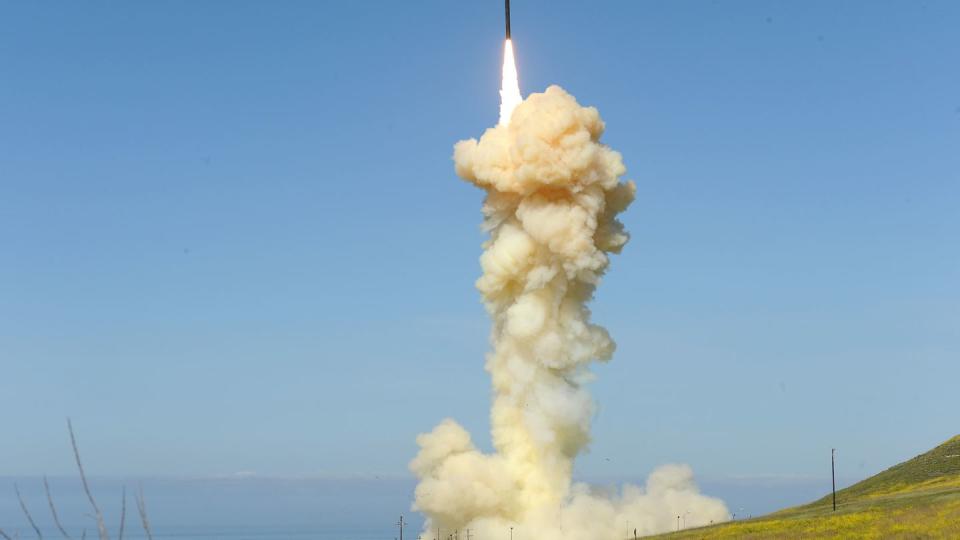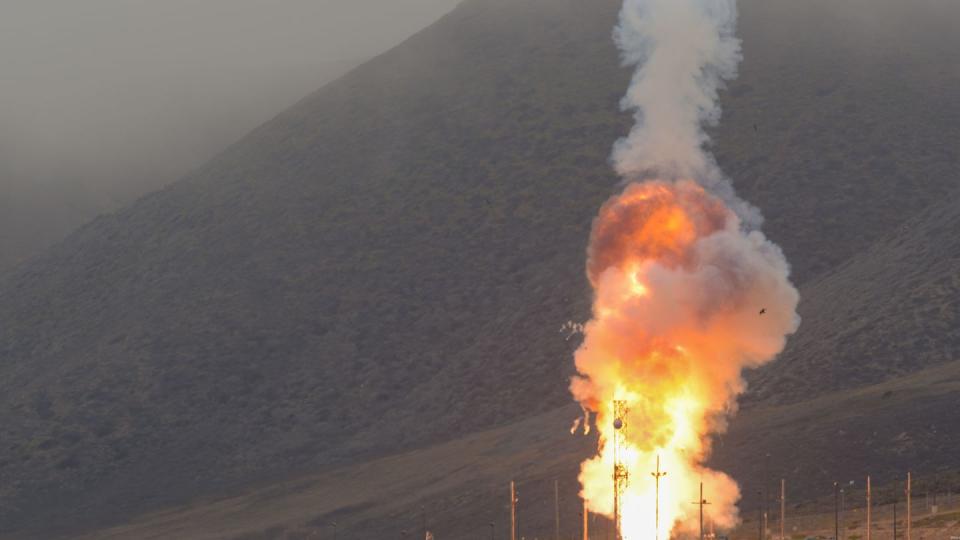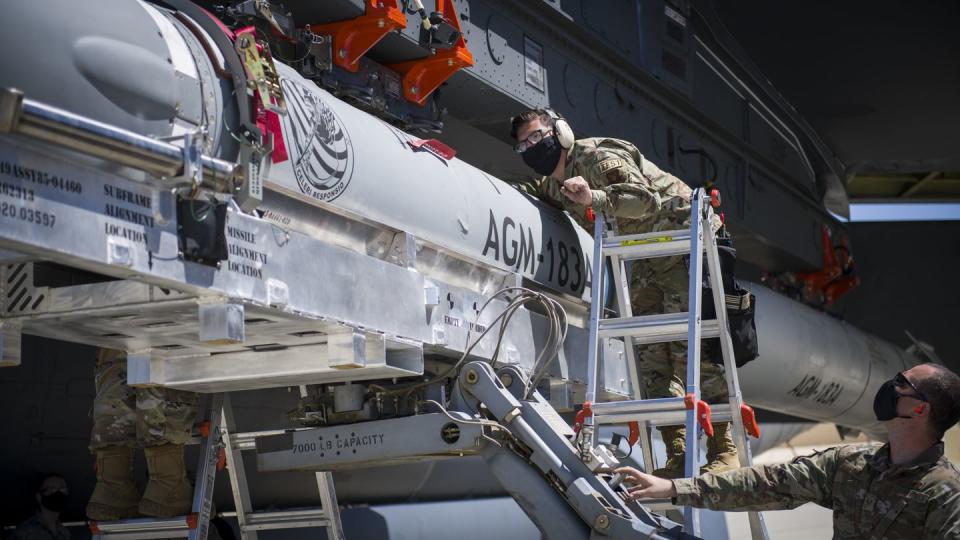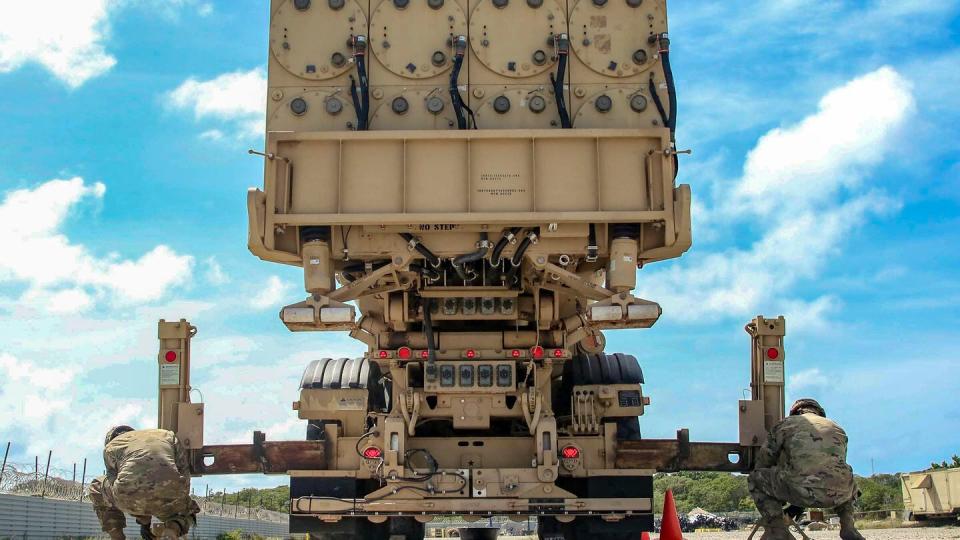What challenges will the next Missile Defense Agency director face?
WASHINGTON — Maj. Gen. Heath Collins spent the last year managing some of the United States’ largest homeland and regional defense programs. Now, he’s poised to lead the Missile Defense Agency, where he would oversee key modernization programs, some of which will overlap with his lengthy background focused on space and satellites.
President Joe Biden in May tapped Collins to be the next MDA director, succeeding Vice Adm. Jon Hill, who has served as the agency’s leader since 2019.
Collins “has an ideal resume for MDA,” said Air Force Brig. Gen. Jason Bartolomei, who served as a deputy to Collins when they worked together on the Ground Based Strategic Deterrent program. Bartolomei now serves as the Air Force’s program executive officer for weapons and leads the Armament Directorate. Collins also held those titles.
“I think his experience in space, nukes, aircraft and weapons has prepared him very well for this opportunity,” he told Defense News.
Among the agency’s efforts the next director will oversee are developing a capability to destroy hypersonic missiles, increasing the use of space sensors, and upgrading the homeland missile defense system to counter increasingly complex ballistic and non-ballistic threats. The agency also recently began building a robust air and missile defense architecture in Guam to protect the island from attack.
Collins “is going to be ideal for the job,” according to Trey Obering III, who led MDA from 2004 to 2008.
“Heath has a great background for not just going to space with his space experience, but also the integration,” he told Defense News “We are fighting in a very integrated world now where we have to tie space, air, land, sea, cyber all into a coherent, integrated warfighting capability.”
Defending the homeland
Collins is now MDA’s program executive officer for ground-based weapons systems at Redstone Arsenal, Alabama. He oversees a $3.4 billion portfolio, which equates to roughly a third of the agency’s overall budget. The portfolio includes the Ground-based Midcourse Defense system, which is undergoing major upgrades.
The GMD system, which dates back nearly two decades, is made up of interceptors in the ground at Fort Greely, Alaska, and Vandenberg Space Force Base, California, that are designed to intercept intercontinental ballistic missiles, potentially fired by North Korea or Iran.

MDA is preparing to update the entire system, including its command-and-control elements, so it can both tackle more complex, emerging threats as well as remain operational. The most significant upgrade is a new, more capable interceptor.
During his tenure, Hill has prioritized homeland missile defense and keeping the GMD system capable of defeating rapidly emerging threats. Underway is a competitive development effort to replace current ground-based interceptors in the GMD system with a Next Generation Interceptor, or NGI.
A Northrop Grumman and RTX team is competing against a Lockheed Martin and Aerojet Rocketdyne team to replace the ground-based interceptors with Next Generation Interceptors.
The aim is to field the NGI by 2028, but industry competitors indicated they can move quicker. A 2021 independent analysis from the Cost Assessment and Program Evaluation office found NGI’s development price tag could total $13 billion, while procurement, operation and sustainment could come to a little more than $2 billion.
Since becoming program executive officer for ground-based weapons systems last summer, Collins has directly overseen the NGI program. The chief MDA role is a six-year term, although most directors serve three to four years. If Collins serves the full length, he could see NGI all the way to the developmental finish line.

“Given the singular importance of the Next Generation Interceptor — the program arguably most closely tied to MDA’s long-term institutional identity — it would be fortuitous for an acquisition professional so close to the program to be able to shepherd it and related efforts to fielding later this decade,” Tom Karako, a missile defense expert at the Center for Strategic and International Studies think tank, told Defense News.
Space-based defense
Even with enhanced missile defense capability from the ground, the next MDA director will need to continue proliferating space-based sensors for tracking and defeating missile threats, Obering said.
Defending the U.S. from Iran and North Korea, while also keeping in mind possible threats from China and Russia, “is going to take a combination of space-based precise tracking and other types of tracking, as well as traditional interceptors with terrestrial capabilities.”
Collins’ experience with satellites dates back to 20-plus years, when he was the manager of advanced satellite payloads at the National Reconnaissance Office in 2001. After two years in the role, he became the chief vehicle engineer at the organization until 2005.
He then spent several years working on wideband satellite communications efforts at the Los Angeles Air Force Base, and about a decade ago he became a deputy director of space and special programs at a Pentagon intelligence office.
The MDA is working with the Space Force to get its Hypersonic and Ballistic Tracking Space Sensor on orbit in fiscal 2023. Hill has said the existing sensor architecture allows for seeing and tracking some hypersonic threats, but being able to do so from space would bolster the agency’s capabilities.
The two HBTSS satellites are expected to launch later this year and will go through on-orbit testing over the next year. If successful, the sensors will be transferred to the Space Development Agency.
Hypersonic threats
MDA is also in the early phases of a program to develop an interceptor to defeat hypersonic missile threats in the glide phase of flight.
From July 2020 to July 2022, Collins was the Air Force’s program executive officer for weapons. In that role, he oversaw the service’s hypersonic weapons programs, including the AGM-183A Air-launched Rapid Response Weapon, a boost glide hypersonic weapon; and the Hypersonic Attack Cruise Missile, which uses a scramjet to breathe in air to reach hypersonic speed.

The AGM-183A ARRW, developed by Lockheed Martin, experienced three test launch failures during 2021 before recovering with a string of successful flight tests in 2022. But a failed all-up round test in March 2023 dealt a serious blow to the program, and its future is now in question.
Collins had ushered the Hypersonic Attack Cruise Missile program through its systems requirements phase; just prior to his 2022 departure, he announced the Air Force would pick a vendor later that year to continue development. A few months after he left the job, the Air Force selected an RTX and Northrop Grumman team to develop the weapon.
If confirmed by the Senate as MDA director, he will manage the agency’s Glide Phase Interceptor, or GPI, effort for regional hypersonic missile defense. The agency has tapped Northrop and RTX to rapidly develop prototypes.
Hill has said MDA wants to accelerate the plan, which now calls for the first delivery in the early 2030s.
‘The hardest three-star job’
The MDA director job “is probably the hardest three-star job in the military,” Obering said, “because first of all it has been controversial ... because it causes the divide between Democrats and Republicans, between the arms control and the warfighting folks, between even things like the use of space for warfighting or for peace.”
Collins will need “people skills and leadership skills” to navigate those complexities and bridge divides, Obering added.
And according to Bartolomei, Collins is just that. “He is a good listener. He is cool under pressure, very steady. I think he is an excellent strategic thinker.”
Collins declined a request for an interview ahead of the confirmation process.
When Hill took the MDA director job in 2019, he told Defense News his No. 1 challenge was dealing with the “poorly defined” MDA charter provision that required the agency, once it finished developing a missile defense capability, to transfer it to one of the services.
MDA transferred the Patriot air and missile defense system to the Army, for example, but Hill said not every program lends itself to such a move.
At the time, lawmakers wanted to move the Terminal High Altitude Area Defense program to the Army. Hill warned that transfer could end up “fracturing a program during a time where it’s most critical to have those programs stable and taking care of the warfighter.”

Lawmakers ultimately backed off, but the debate could resurface, as Collins is likely to face increased attention from Congress on MDA’s work.
For instance, a group of New York lawmakers is pushing for a third homeland missile defense site on the East Coast, something previous MDA directors resisted due to budget constraints.
Also in recent years, lawmakers showed interest in what MDA and the services were doing to develop an air and missile defense architecture for Guam, in addition to pushing for a missile defense radar in Hawaii that the agency refuses to fund.
For example, a provision in the Senate Armed Services Committee’s FY24 defense authorization bill requires MDA to produce a strategy for “developing, acquiring and operationally establishing an integrated air and missile defense architecture” for not just Guam but the entire Indo-Pacific theater.
The House version of the bill calls on the agency’s director to produce a report on options for enhancing missile defense protection of the homeland “to hedge against the uncertainty of the future missile threats and technical risk in the U.S. missile defense development plans.”

